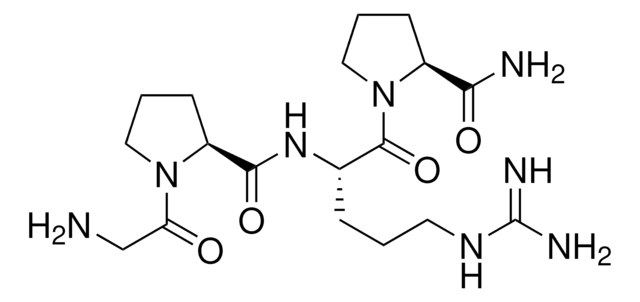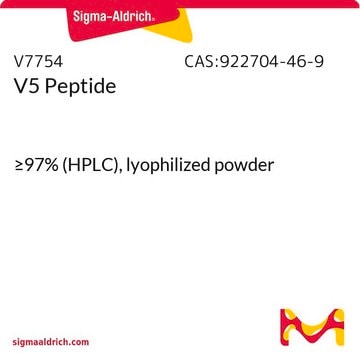G4541
Gly-Gly-His
≥98% (TLC)
Synonym(s):
Copper-binding peptide
Sign Into View Organizational & Contract Pricing
All Photos(1)
About This Item
Empirical Formula (Hill Notation):
C10H15N5O4
CAS Number:
Molecular Weight:
269.26
MDL number:
UNSPSC Code:
12352209
NACRES:
NA.26
Recommended Products
product name
Gly-Gly-His,
Assay
≥98% (TLC)
form
solid
color
white
storage temp.
−20°C
InChI
1S/C10H15N5O4/c11-2-8(16)13-4-9(17)15-7(10(18)19)1-6-3-12-5-14-6/h3,5,7H,1-2,4,11H2,(H,12,14)(H,13,16)(H,15,17)(H,18,19)
InChI key
PDAWDNVHMUKWJR-UHFFFAOYSA-N
Related Categories
Amino Acid Sequence
Gly-Gly-His
General description
Gly-Gly-His (GGH) tripeptide with carboxyl-terminal histidine residue is hydrophilic.
Application
Gly-Gly-His has been used:
- as a peptide test probe in the hydrophilic interaction liquid chromatography (HILIC) studies
- in the electrochemical modification of back-side contact transducers (BSC) electrodes in copper (Cu2+) sensing studies
- for the fabrication carbon nanotube electrode for detection of Cu2+ ions
Biochem/physiol Actions
Gly-Gly-His (GGH) tripeptide displays the affinity of copper (Cu2+) complexation. These complexes display good skin tolerance and may be useful in wound healing. GGH copper complexes are proposed to reduce tumor necrosis factor α (TNF-α)-based interleukin 6 (IL-6) secretion by in vivo studies with fibroblasts. GGH is used in comparative studies with other imidazole-containing peptides such as carnosine. An area of active application research involves the GGH binding of copper ions.
Storage Class Code
11 - Combustible Solids
WGK
WGK 3
Flash Point(F)
Not applicable
Flash Point(C)
Not applicable
Personal Protective Equipment
dust mask type N95 (US), Eyeshields, Gloves
Certificates of Analysis (COA)
Search for Certificates of Analysis (COA) by entering the products Lot/Batch Number. Lot and Batch Numbers can be found on a product’s label following the words ‘Lot’ or ‘Batch’.
Already Own This Product?
Find documentation for the products that you have recently purchased in the Document Library.
Customers Also Viewed
Ken Yokawa et al.
Bioscience, biotechnology, and biochemistry, 75(7), 1377-1379 (2011-07-09)
Free divalent ions of copper (Cu) are capable of generating radical species such as hydroxyl radicals in the presence of hydrogen peroxide or ascorbic acid through Harbor-Weiss-like reactions under physiological conditions. It has been reported that radical-mediated damage to DNA
Electrochemical detection of copper using a Gly-Gly-His modified carbon nanotube biosensor
Flavel BS, et al.
Silicon, 3(4) (3)
P C Joshi
Indian journal of biochemistry & biophysics, 35(4), 208-215 (1998-12-17)
Reactive oxygen species (ROS) are considered to play an important role in tissue injury that damages DNA, proteins, carbohydrates and lipids. Increased production of ROS and/or decreased efficiency of antioxidant defense system has been shown to contribute to a number
Hirokazu Hamada et al.
Journal of inorganic biochemistry, 101(10), 1529-1536 (2007-08-21)
DNA fiber EPR was used to investigate the DNA binding stabilities and orientations of Cu(II).Gly-Gly-His-derived metallopeptides containing D- vs. L-amino acid substitutions in the first peptide position. This examination included studies of Cu(II).D-Arg-Gly-His and Cu(II).D-Lys-Gly-His for comparison to metallopeptides containing
A P Dicks et al.
Chemistry & biology, 3(8), 655-659 (1996-08-01)
We have recently shown that S-nitrosothiols (RSNOs) decompose in aqueous buffer to give nitric oxide, an important signalling molecule, and the corresponding disulphides. This occurs by reaction with Cu+ generated from Cu2+ (supplied as hydrated Cu2+) by thiolate reduction. To
Our team of scientists has experience in all areas of research including Life Science, Material Science, Chemical Synthesis, Chromatography, Analytical and many others.
Contact Technical Service










